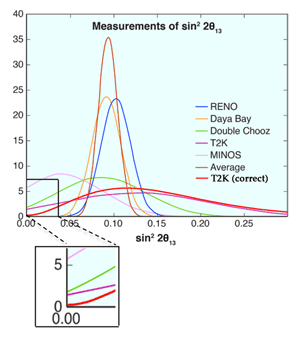Measuring the Neutrino Mixing Angle θ13
We read Janet Conrad’s Viewpoint article “Rethinking the neutrino” (23 April 2012), describing the Daya Bay collaboration’s measurement of a large neutrino oscillation, with great interest. We applaud Professor Conrad for successfully conveying the excitement in the field: in less than one year, experimental collaborations around the world have established that the neutrino mixing angle θ13 is nonzero and large. Since most of the experiments were designed for the long haul, nature’s choice of a large θ13 is indeed a tremendous gift, which now opens a path for us to resolve the neutrino mass hierarchy and look for evidence of CP violation in the lepton sector.
However, we would like to reiterate that it was the T2K collaboration that first reported θ13 is both nonzero and large.
In July of 2011, T2K published results [1,2], that indicated nonzero θ13 with a 2.5σ level of significance (or, a p value of 0.007). This result was subsequently confirmed by the MINOS and Double Chooz collaborations and a combined fit of all of these results showed a large θ13 value with more than a 3σ level of significance [3]. Although the Viewpoint article stated that T2K result was confusing, we would like to point out that T2K employed a carefully designed off-axis neutrino oscillation measurement technique that involved a rather straightforward analysis—essentially, it was a counting experiment. It should be also noted that T2K is an experiment specifically designed and built to look for electron-neutrino appearance at the oscillation maximum. Thus the result was not affected by the so-called “look-elsewhere” effect, which can create apparent signals in searches for new resonances or particles in a large parameter space that later disappear when more data are taken.
Finally, we understand that the purpose of Fig. 1 in the Viewpoint was to illustrate how vastly the results have improved within a year period. However, because it was a simplified plot, the distribution in the tails was not shown correctly. Here (Fig. 1) we show an unpublished plot for sin22θ13 based on the published T2K results [1]. The plot shows that the results were not consistent with a θ13 equal to zero.
References
- K. Abe et al. (T2K Collaboration), Phys. Rev. Lett. 107, 041801 (2011)
- S. Parke, Physics 4, 57 (2011)
- G. L. Fogli, E. Lisi, A. Marrone, A. Palazzo, and A. M. Rotunno, Phys. Rev. D 84, 053007 (2011)





